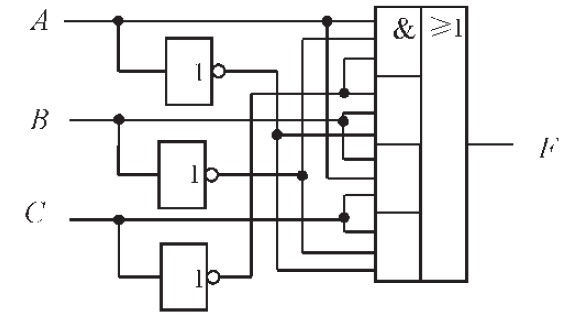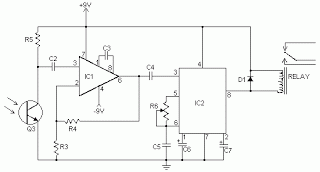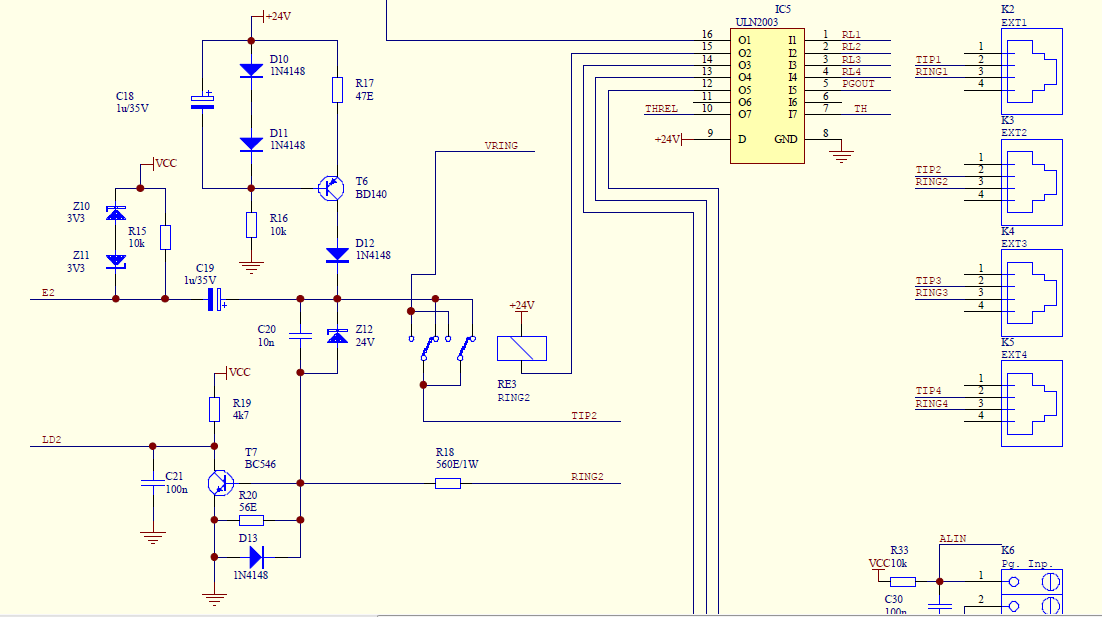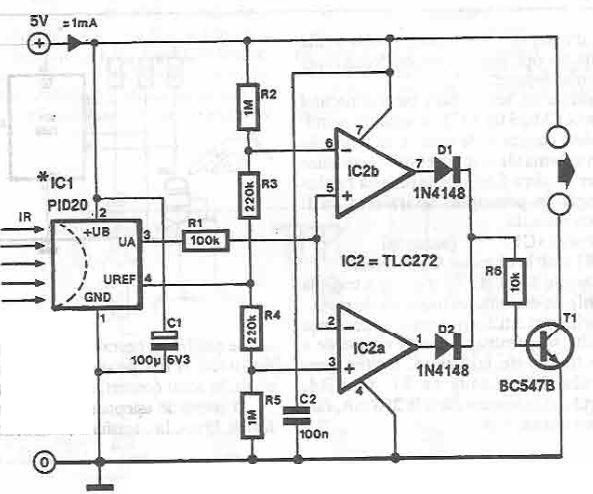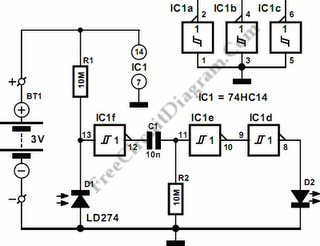
Infra Red Switchs
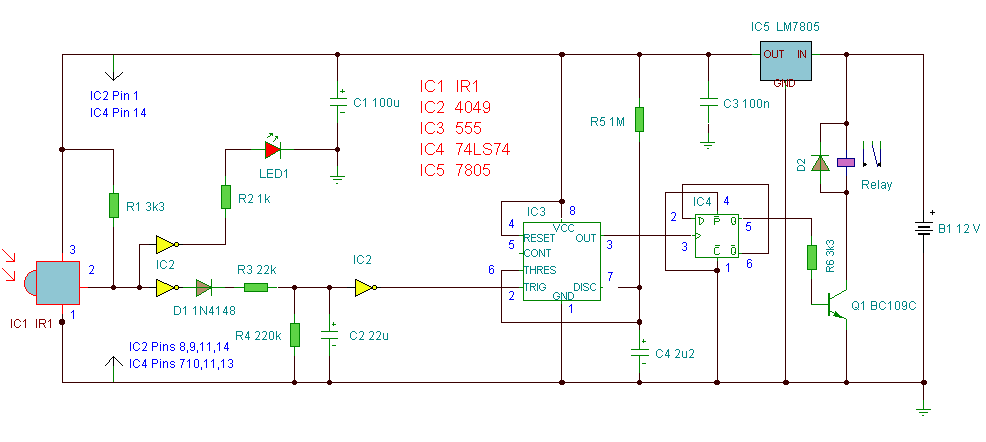
Any button from any remote control can be used to operate this universal switch. The button needs to be pressed for two seconds (determined by R3 and C2) before the relay activates. Once activated, the circuit remains latched in this state until it is reset. To reset, any button must be pressed and held for the same duration. For instance, if the television is tuned to Channel 3, pressing and holding the remote control's Channel 3 button for two seconds will activate the relay without disrupting the TV viewing. The relay can be connected to any device, such as a lamp, provided that the relay contacts are rated for the appropriate voltage and current. IC1 is an infrared module that receives and buffers IR modulated pulses. It has a standard TTL output, where the absence of a signal is represented as logic 1. One gate of a CMOS inverter drives a red LED (LED1) as a visual indicator of switching. Another gate buffers the signal and feeds it into a timing circuit composed of R3, C2, R4, and D1. Capacitor C2 charges through resistor R3 and discharges through resistor R4, while diode D1 prevents rapid discharge due to the low output impedance of the CMOS buffer. The incoming pulses are further buffered, which may result in "jagged edges" as illustrated. These edges, produced by the modulated IR data, need to be removed. This is accomplished using IC3, a 555 timer configured as a monostable, with the pulse duration determined by R5 and C4. This setup cleanly reconstructs a single pulse to activate the bistable latch. A D-type flip-flop, IC4, is configured as a bistable device. The input is connected to the clock pin, the inverted output is fed back to the data input, and the clear and preset lines are grounded. With each pulse, the relay will activate and latch, while the subsequent pulse will deactivate the relay. It is important to note that rapid switching of the relay is not feasible. The output pulse duration is set at approximately 1.5 seconds, while the input delay, determined by R3 and C2, is set at two seconds.
This universal switch circuit utilizes a remote control to toggle a relay, allowing for remote operation of various electrical devices. The key components include an infrared receiver (IC1), which captures modulated IR signals from the remote control. The TTL output from IC1 indicates the presence or absence of an IR signal, facilitating the activation of the circuit. The visual indicator (LED1) provides feedback to the user, confirming that the relay is being activated.
The timing circuit, consisting of the resistors and capacitors (R3, C2, R4, and D1), plays a crucial role in establishing the delay required for activation and deactivation of the relay. The charging and discharging behavior of capacitor C2, governed by resistors R3 and R4, determines the duration that the button must be pressed to engage the relay. Diode D1 ensures that the capacitor does not discharge too quickly, allowing for a stable timing mechanism.
The 555 timer (IC3) is configured in monostable mode to generate a clean, single pulse that eliminates any noise from the incoming IR signals. This pulse is essential for triggering the D-type flip-flop (IC4), which is set up as a bistable latch. The flip-flop's clock pin receives the clean pulse, and its feedback configuration ensures that the relay toggles its state with each pulse. This design effectively allows for a simple yet reliable method of controlling devices remotely.
In summary, this circuit provides a robust solution for remote control operation of electrical devices, ensuring that the relay can be activated and deactivated with a simple button press, while also providing visual feedback and maintaining stability through careful timing and signal processing.Any "button" of any remote control may be used to work this universal switch. The button must be pressed for two seconds (determined by R3 and C2) before the relay will operate. Once operated the circuit will remain in this state (latched) until reset. To reset, any button is pressed and held for the delay. For example, if you were watching TV, an d your set was tuned to Channel 3, you could press and hold the TV remote controls channel 3 button for two seconds. That way the TV viewing would not be affected and the relay would activate. You can connect anything to the relay, for example a lamp, but make sure that the relay contacts can handle the rated voltage and current.
IC1 is an Infra Red module. IR modulated pulses are received and buffered by this IC. It has a standard TTL output, the output with no signal is logic 1. One gate of a CMOS inverter and drives Red LED1 as a visible switching aid. Another gate buffers the signal and applies it to the time constant circuit, comprising R3, C2, R4 and D1. C2 charges via R3, and discharges via R4, D1 prevents quick discharge via the low output impedance of the CMOS buffer.
The pulses are further buffered and contain "jaggered edges" as shown above. These edges are produced by the modulated IR data, which has to be removed. This is achieved using IC3, a 555 timer wired as a monostable, pulse duration R5, C4. These cleanly reconstructs a single clean pulse to activate the bistable latch. A D type flip flop, IC4 is configured as a bistable. The input is applied to the clock pin, the inverted output fed back to the data input and clear and preset lines are tied to ground. For every pulse the relay will operate and latch, the next pulse will turn off the relay and so on. Note that quick turn on and off of the relay is not possible. The output pulse is set at about 1. 5 seconds and input delay by R3, C2 set at two seconds. 🔗 External reference
This universal switch circuit utilizes a remote control to toggle a relay, allowing for remote operation of various electrical devices. The key components include an infrared receiver (IC1), which captures modulated IR signals from the remote control. The TTL output from IC1 indicates the presence or absence of an IR signal, facilitating the activation of the circuit. The visual indicator (LED1) provides feedback to the user, confirming that the relay is being activated.
The timing circuit, consisting of the resistors and capacitors (R3, C2, R4, and D1), plays a crucial role in establishing the delay required for activation and deactivation of the relay. The charging and discharging behavior of capacitor C2, governed by resistors R3 and R4, determines the duration that the button must be pressed to engage the relay. Diode D1 ensures that the capacitor does not discharge too quickly, allowing for a stable timing mechanism.
The 555 timer (IC3) is configured in monostable mode to generate a clean, single pulse that eliminates any noise from the incoming IR signals. This pulse is essential for triggering the D-type flip-flop (IC4), which is set up as a bistable latch. The flip-flop's clock pin receives the clean pulse, and its feedback configuration ensures that the relay toggles its state with each pulse. This design effectively allows for a simple yet reliable method of controlling devices remotely.
In summary, this circuit provides a robust solution for remote control operation of electrical devices, ensuring that the relay can be activated and deactivated with a simple button press, while also providing visual feedback and maintaining stability through careful timing and signal processing.Any "button" of any remote control may be used to work this universal switch. The button must be pressed for two seconds (determined by R3 and C2) before the relay will operate. Once operated the circuit will remain in this state (latched) until reset. To reset, any button is pressed and held for the delay. For example, if you were watching TV, an d your set was tuned to Channel 3, you could press and hold the TV remote controls channel 3 button for two seconds. That way the TV viewing would not be affected and the relay would activate. You can connect anything to the relay, for example a lamp, but make sure that the relay contacts can handle the rated voltage and current.
IC1 is an Infra Red module. IR modulated pulses are received and buffered by this IC. It has a standard TTL output, the output with no signal is logic 1. One gate of a CMOS inverter and drives Red LED1 as a visible switching aid. Another gate buffers the signal and applies it to the time constant circuit, comprising R3, C2, R4 and D1. C2 charges via R3, and discharges via R4, D1 prevents quick discharge via the low output impedance of the CMOS buffer.
The pulses are further buffered and contain "jaggered edges" as shown above. These edges are produced by the modulated IR data, which has to be removed. This is achieved using IC3, a 555 timer wired as a monostable, pulse duration R5, C4. These cleanly reconstructs a single clean pulse to activate the bistable latch. A D type flip flop, IC4 is configured as a bistable. The input is applied to the clock pin, the inverted output fed back to the data input and clear and preset lines are tied to ground. For every pulse the relay will operate and latch, the next pulse will turn off the relay and so on. Note that quick turn on and off of the relay is not possible. The output pulse is set at about 1. 5 seconds and input delay by R3, C2 set at two seconds. 🔗 External reference
Warning: include(partials/cookie-banner.php): Failed to open stream: Permission denied in /var/www/html/nextgr/view-circuit.php on line 713
Warning: include(): Failed opening 'partials/cookie-banner.php' for inclusion (include_path='.:/usr/share/php') in /var/www/html/nextgr/view-circuit.php on line 713
